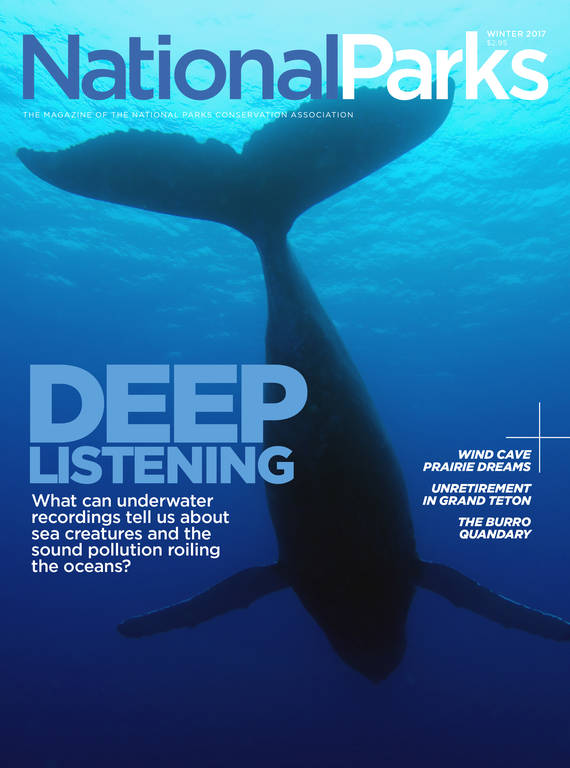Winter 2017
Seeing the Light
The discovery of a rare blind catfish in Texas could have far-ranging implications for water and land use.
In April 2015, Jack Johnson found himself crouching in a cave in Amistad National Recreation Area, a site that includes a large reservoir on the Rio Grande along the Texas-Mexico border. He and his colleagues were exploring the newly discovered cave, and since Johnson, a park ranger and archaeologist, was the smallest team member, he had bent down to measure the cave’s floor.
Suddenly, Johnson saw a flurry of movement inside a pool. He looked closer and saw a tiny pinkish fish with no eyes.
Johnson couldn’t be sure, but he believed he had laid eyes on the Mexican blindcat, a catfish endangered in Mexico and never before spotted in the United States. One of three rare catfish species in Texas that live only in groundwater, Prietella phreatophila has become blind and nearly pigment-less over millions of years of adaptation. First described in northeastern Mexico in 1954, it was long rumored to be in the area. Still, it hadn’t been caught there, though many explorers had looked for it.
For more than a decade, Johnson himself had heard stories about the legendary fish believed to be living in the shallow water flowing between the caves. Unfortunately, he didn’t have a camera, a phone or a dip-net with him that day. He believed he had caught sight of a fish that was not only extremely rare, but one that could demonstrate the connectivity between groundwater in the United States and Mexico and have huge implications for water and land use. But unable to capture it, he had to let it go.
WATER PARK
For the next year, Johnson and a community of dedicated cavers and researchers combed Amistad’s crevices, searching for the elusive fish. Last May, the efforts finally paid off. Johnson was exploring a pool with Peter Sprouse, a biologist and longtime friend. Since Johnson’s discovery, Sprouse had organized regular caving trips to hunt for the catfish with other keen-eyed observers. The habitat was difficult to access and the trips had been fruitless, but Sprouse was convinced they were looking in the right spot. Scientists had discovered the catfish on the Mexican side of the border, and park officials and cave enthusiasts had long suspected the waters beneath the caves were connected underground.
With Johnson nearby, Sprouse rappelled 60 feet down into the cave, squeezed into a vertical crack and then forced himself into another crevice. He saw movement. Headlamp on and video camera in hand, he documented the first confirmed sighting of the Mexican blindcat on this side of the border, then used his dip-net to take the fish out of the cave pool. Within an hour, they had found two more. Later, Dean Hendrickson, curator of ichthyology at the University of Texas at Austin, confirmed the identifications.
“This is exciting because they’re so difficult to find,” Sprouse said. “We have been searching for them pretty intensively since 1999.”
The Edwards-Trinity Aquifer under Amistad, which supplies drinking water to people in southwestern Texas and Coahuila in Mexico, is karst, a porous geological formation that makes groundwater highly susceptible to contamination. On the Mexican side of the border, coal mining, natural gas exploration, agriculture and even beer brewing all affect both the water levels and the water quality. On the U.S. side, new housing developments and agriculture put increasing pressure on the aquifer. The fish’s discovery and its endangered status could help protect the aquifer and lead to restrictions on water withdrawals as well as limits on pollution from nearby agriculture, including runoff from fertilizer, Hendrickson said.
Mexican blindcats have adapted to an environment where few other species survive. These caves are dark, the water level variable and the food sources — mostly aquatic crustaceans — scarce. As a result, the 3-inch-long fish have a keen sense of smell and are able to endure long periods without food.
Hendrickson, who has been studying these catfish for decades, is hoping that the discovery on the Texas side of the border allows for a global conservation assessment of the species to determine its prospects for survival. That will be difficult, because the habitat is deep underground and accessible only through tight crevices. One positive development: The fish’s endangered status in Mexico also applies here.

National Parks
You can read this and other stories about history, nature, culture, art, conservation, travel, science and more in National Parks magazine. Your tax-deductible membership donation of $25 or more entitles…
See more ›The three specimens Sprouse and Johnson collected are at the San Antonio Zoo and Aquarium, though not on display. Researchers hope one day to start a breeding program and re-introduce the fish to the areas with suitable habitat. It’s a delicate process, as Hendrickson knows: In the 1990s, he attempted to breed specimens he found in Mexico. Though some of those captive fish are still living nearly two decades later, the breeding program wasn’t very successful. One pair spawned several times, but the male either ate the eggs, or they never hatched for unknown reasons. With the fish caught in Amistad, the situation is further complicated by the fact that scientists are not yet sure if those fish are male or female.
A successful breeding program that would boost the species’ chances of long-term survival will likely require capturing more fish. At least now scientists know where to look: in the caves of Amistad that are filled with water from underground springs.
“The geology told us they should be there,” Hendrickson said. “We figured one day we would find them, and sure enough, we did. It just took a long time.”
About the author
-
 Rona Kobell Author
Rona Kobell AuthorRona Kobell, a frequent National Parks magazine contributor, is the co-founder of the Environmental Justice Journalism Initiative. She is also a professor of journalism and has written about the Chesapeake Bay for 20 years. Reach her at rona@ejji.org.



